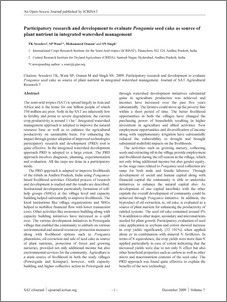Participatory research and development to evaluate Pongamia seed cake as source of plant nutrient in integrated watershed management
Abstract
The semi-arid tropics (SAT) is spread largely in Asia and Africa and is the home for one billion people of which 350 million are poor. Soils in the SAT are inherently low in fertility and prone to severe degradation; the current crop productivity is around 1 t ha-1. Integrated watershed management approach is adopted to improve the natural resource base as well as to enhance the agricultural productivity on sustainable basis. For enhancing the impact through greater adoption of improved technologies participatory research and development (PRD) tool is quite effective. In the integrated watershed development approach PRD is adopted to a large extent. The PRD approach involves diagnosis, planning, experimentation and evaluation. All the steps are done in a participatory mode. The PRD approach is adapted to improve livelihoods of the tribals in Andhra Pradesh, India using Pongamia¬based livelihood activities. Detailed process of research and development is studied and the results are described. Institutional development particularly formation of self¬help groups (SHGs) at the village level and capacity building helped substantially to improve livelihoods. The local institutions like village organizations and SHGs helped to mobilize financial flow with lower transaction costs. Other activities like awareness building along with capacity building initiatives have increased as a spill over. The various development initiatives in Powerguda village that enabled the community to embark on various environmental and natural resources protection measures along with livelihood options such as Pongamia plantations, oil extraction and sale of seed cake as source of plant nutrients, protection of forest and growing nurseries, provided not only additional income but also environmental services for the community. Agriculture is a main source of livelihood in both the study villages (Powerguda and Kistapur); however, with capacity building and higher collective action in Powerguda and through watershed development initiatives substantial gains in agriculture production was achieved and incomes have increased over the past five years substantially. The farmers could move up the poverty line within a short period of time. The better livelihood opportunities in both the villages have changed the purchasing power of households resulting in higher investment in agriculture and allied activities. New employment opportunities and diversification of income along with supplementary irrigation have substantially reduced the vulnerability to drought and brought substantial multifold impacts on the livelihoods. The activities such as growing nursery, collecting seeds and extracting oil in the village provide employment and livelihood during the off-season in the village, which not only bring additional income but also gender equity, as the wage rates related to Pongamia seed collection are same for both male and female laborers. Through development of social and human capital along with financial capital the community is able to undertake initiatives to enhance the natural capital also. As development of one capital interlinks with the other capitals the overall development of community could be achieved through Pongamia initiative. In addition, the byproduct of oil extraction, ie, oil cake, is evaluated as a source of plant nutrient for enhancing the productivity of rainfed systems. The seed oil cake contained around 4% N in addition to other major, secondary and micronutrients needed for plant growth. Participatory evaluation of seed cake application to soybean and cotton showed increase in crop yields significantly (32-101%) when applied alone or in combination with mineral N fertilizers. In terms ofN equivalence, the crop yields were more than N applied particularly in case of cotton indicating that the increased yields were due to not only N effect but also other beneficial properties such as carbon as well as other micro and macronutrient contents of the seed cake. The PRD approach was found quite effective to explain the benefits of the new technology

